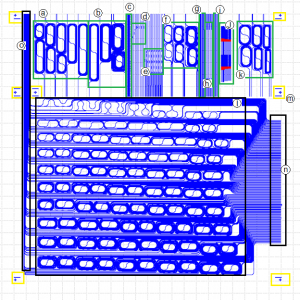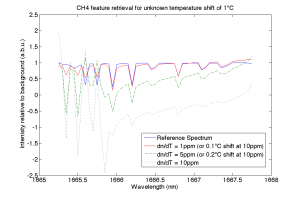Project Lead -- Hugh Podmore
Project Members -- Arthur Lin, Chris Sioris, Juan Guzman, Zachary Corriveau

This chip layout shows the microspectrometer design. The components consist of (a)-(k) device characterization test structures, (l) central block of 100 MZIs, (m) dicing fiducials, (n) linear exit array at 50um pitch, (o) input aperture.
Nanosatellite laboratory students, in collaboration with COM DEV Ltd, and the National Research Council of Canada (NRCC) are working to develop a thermally stabilized spectrometer for remote-sensing applications based on microphotonic waveguide technology. Nanosatellite laboratory researchers are aiming to demonstrate remote-detection of Methane using a Spatial Heterodyne Spectrometer (SHS) consisting of an array of Mach-Zehnder Interferometers (MZIs) realized via Silicon Nitride strip waveguides on a single microchip.
The microspectrometer instrument consists of 100 pairs of infrared waveguides laid out on a single wafer. Each waveguide is analagous to an optical fibre, hence the instrument consists of 200 individual paths for light to travel through. Each waveguide pair begins as a single waveguide and is then split into two waveguides which are mismatched in length. The path difference between the two waveguides yields a corresponding phase difference in the light; when the waveguides are re-combined an interference pattern is produced. Each waveguide pair or MZI is analagous to a michaelson interferometer set to a fixed position. Using 100 MZI pairs on a single chip produces a set of interferometers each in a different fixed position, just as if a single interferometer were being driven by a stepper motor. Taken all-together this system is a self-contained Fourier Transform Spectrometer (FTS) operating under the SHS principle.

This graph shows the effect of small temperature variations on a simulated CH4 spectrum retrieval. Our system aims to achieve dn/dT minimization to 1 ppm, note that traditional Silicon photonics platforms have a typical dn/dT value of 100ppm.
To address the major design challenge of this instrument (thermal stability) our researchers are working to realize a temperature-insensitive or temperature-compensated photonic system that will ensure faithful atmospheric retrieval even in challenging environments.
This instrument is expected to reach completion in Q1 2017.
For more information on this project see the following paper:
http://proceedings.spiedigitallibrary.org/proceeding.aspx?articleid=1337881
Students interested in participating in this project should contact Professor Regina Lee (reginal@yorku.ca) or PhD candidate Hugh Podmore (podmore@yorku.ca).

